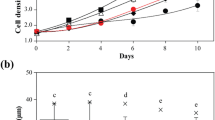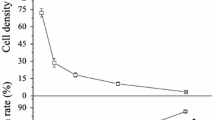Abstract
Chlorine (Cl2) is a commonly used biocide; however, the cellular mechanism and pathways associated with Cl2 exposure in algae have not been elucidated. Here, we investigated the physiological and gene transcriptional responses in the dinoflagellate Prorocentrum minimum upon chlorination, with emphasis on the photosynthetic system. The time-course stress response of P. minimum was assessed by measuring transcription of photosynthesis-related genes, chlorophyll autofluorescence (CAF), and photosynthesis efficiency (F v /F m ), in response to a series of Cl2 doses (0.1, 0.5, and 1.0 mg L−1). CAF data showed a marked reduction in fluorescence intensity with increasing Cl2 doses and exposure time (0, 6, 12, and 24 h). F v /F m dramatically decreased after 1 mg L−1 Cl2 exposure. Transcriptional responses of the photosystem related genes (PmpsbA, PmatpB, PmrbcL, and PmpsaA) were analysed using quantitative real-time (qRT)-PCR. PmpsbA transcription was significantly upregulated in 0.5 and 1.0 mg L−1 of Cl2 after a 24 h exposure. However, the transcriptional expressions of PmatpB and PmpsaA were downregulated. Our results suggest that photosynthesis-related genes such as PmpsbA may act as indicators of environmental stress response and can be useful and rapid biomarker candidates for ecotoxicogenomic assessments.







Similar content being viewed by others
References
American Public Health Association (APHA) (1998) Standard methods for the examination of water and wastewater, 20th edn. American Public Health Association, Washington, DC, USA
Baker NR (2008) Chlorophyll fluorescence: a probe of photosynthesis in vivo. Annu Rev Plant Biol 59:89–113
Bellemare F, Rouette ME, Lorrain L, Perron E, Boucher N (2006) Combined use of photosynthetic enzyme complex and microalgal photosynthetic systems for rapid screening of wastewater toxcity. Environ Toxicol 21:445–449
Calderon RL (2000) The epidemiology of chemical contaminants of drinking water. Food Chem Toxicol 38:513–520
Campbell K, Farrel SO (2009) Photosynthesis (6th ed). Thomson Brooks, Belmont, CA, pp. 645–670
Campbell NA, Reece J B, Taylor MR, Simon EJ (2006) Photosynthesis: using light to make food. In: Biology concepts and connections, 5th edn. Benjamin Cummings, San Francisco, p 107–121
Chang MW, Toghrol F, Bentley WE (2007) Toxicogenomic response to chlorination includes induction of major virulence genes in Staphylococcus aureus. Environ Sci Technol 41:7570–7575
Draber W, Tietjen K, Kluth JF, Trebst A (1991) Herbicides in photosynthesis research. Angew Chem Int Ed Engl 30:1621–1633
Ebenezer V, Ki JS (2013) Physiological and biochemical responses of the marine dinoflagellate Prorocentrum minimum exposed to the oxidizing biocide chlorine. Ecotoxicol Environ Saf 92:129–134
Ebenezer V, Nancharaiah YV, Venugopalan VP (2012) Chlorination-induced cellular damage and recovery in marine microalga, Chlorella salina. Chemosphere 89:1042–1049
Ebenezer V, Lim WA, Ki JS (2014) Effects of the algicides CuSO4 and NaOCl on various physiological parameters in the harmful dinoflagellate Cochlodinium polykrikoides. J Appl Phycol 26:2357
Eberhard S, Drapier D, Wollman F-A (2002) Searching limiting steps in the expression of chloroplast - encoded proteins: relations between gene copy number, transcription, transcript abundance and translation rate in the chloroplast of Chlamydomonas reinhardtii. Plant J 31:149–160
Environment Agency (2011) Chemical discharges from nuclear power stations: historical releases and implications for best available techniques. Environmental Agency, Bristol Report-SC 090012/R1
Eriksson KM, Clarke AK, Franzen LG, Kuylenstierna M, Martinez K, Blanck H (2009) Community-level analysis of psbA gene sequences and irgarol tolerence in marine periphyton. Appl Environ Microbio l75:897–906
Escher BI, Hermens JL (2002) Modes of action in ecotoxicology: their role in body burdens, species sensitivity, QSARs, and mixture effects. Environ Sci Technol 36:4201–4217
Falkowski PG, Raven JA (1997) Aquatic photosynthesis. Blackwell Science, London, pp 375
Fan X, Zhang Z, Gao H, Yang C, Liu M, Li Y, Li P (2014) Photoinhibition-like damage to the photosynthetic apparatus in plant leaves induced by submergence treatment in the dark. PLoS One 9:e89067
Franklin NM, Adams MS, Stauber JL, Lim RP (2001) Development of an improved rapid enzyme inhibition bioassay with marine and freshwater microalgae using flow cytometry. Arch Environ Contam Toxicol 40:469–481
Guillard RRL (1975) Culture of phytoplankton for feeding marine invertebrates. In: Smith WL, Chanley MH (eds) Culture of marine invertebrate animals. Plenum Press, New York, pp. 29–60
Guo R, Ki JS (2012) Differential transcription of heat shock protein 90 (HSP90) in the dinoflagellate Prorocentrum minimum by copper and endocrine-disrupting chemicals. Ecotoxicology 21:1448–1457
Guo R, Ebenezer E, Ki JS (2014) PmMGST3, a novel microsomal glutathione S-transferase gene in the dinoflagellate Prorocentrum minimum, is a potential biomarker of oxidative stress. Gene 546:378–385
Guo R, Lim WA, Ki JS (2016) Genome-wide analysis of transcriptional response and photosynthesis inhibition in the harmful dinoflagellate Prorocentrum minimum in response to the biocide copper sulfate. Harmful Algae 57:27–38
Hackett JD, Anderson DM, Erdner DL, Bhattacharya D (2004) Dinoflagellates: a remarkable evolutionary experiment. Am J Bot 91:1523–1534
Heil HA, Glibert PA, Fan C (2005) Prorocentrum minimum (Pavillard) Schiller: a review of a harmful algal bloom species of growing worldwide importance. Harmful Algae 4:449–470
Jamers A, Van der Ven K, Moens L, Robbens J, Potters G, Guisez Y, Blust R, De Coen W (2006) Effect of copper exposure on gene expression profiles in Chlamydomonas reinhardtii based microarray analysis. Aquat Toxicol 80:249–260
Lattemann S, Höpner T (2008) Environment impact and impact assessment of seawater desaliantion. Desalination 220:1–15
Levitan O, Kranz SA, Spungin D, Prásil O, Rost B, Berman-Frank I (2010) Combined effects of CO2 and light on the N2-fixing cyanobacterium Trichodesmium IMS101: a mechanistic view. Plant Physiol 154:346–356
Lin S, Zhang H, Jiao N (2006) Potential utility of mitochondrial cytochrome b and its mRNA editing in resolving closely related dinoflagellates: a case study of Prorocentrum (Dinophyceae). J Phycol 42:646–654
Lyska D, Meierhoff K, Westhoff P (2013) How to build functional thylakoid membranes: from plastid trnascription to protein complex assembly. Planta 237:413–428
Ma Z, Gao K, Li W, Xu Z, Lin H, Zheng Y (2011) Impacts of chlorination and heat shocks on growth, pigments and photosynthesis of Phaeodactylum tricornutum (Bacillariophyceae). J Exp Mar Biol Ecol 397:214–219
McGinley MP, Aschaffenburg MD, Pettay DT, Smith RT, LaJeunesse TC, Warner ME (2012) Transcriptional response of two core photosystem genes in Symbiodinium spp. exposed to thermal stress. PLoS One 7(12):e50439
Mori S, Castoreno A, Lammers PJ (2002) Transcript levels of rbcR1, ntcA, and rbcL/S genes in cyanobacterium Anabaena sp. PCC 7120 are downregulated in response to cold and osmotic stress. FEMS Microbiol Lett 213:167–173
Nancharaiah YV, Rajadurai M, Venugopalan VP (2007) Single cell level microalgal ecotoxicity assessment by confocal laser scanning microscopy and digital image analysis. Environ Sci Technol 41:2617–2621
Nelson DL, Cox MM (2008) Bioenergitics and metabolism. In: Lehninger principles of biochemistry (5th Ed). W. H. Freeman & company, New York, pp. 489–804
Organisation for Economic Cooperation and Development (OECD) (2011) OECD guidelines for the testing of chemicals. Freshwater algal and cyanobacteria growth inhibition test. 201. OECD Publications, Paris
Park S-Y, Choi E-S, Hwang J, Kim D, Ryu T-K, Lee T-K (2009) Physiological and biochemical responses of Prorocentrum minimum to high light stress. Ocean Sci J 44:199–204
Parsons TR, Maita Y, Lalli CM (1984) A manual of chemical and biological methods for seawater analysis. Pergamon Press, Oxford, p. 84
Patil JS, Jagadeesan V (2011) Effect of chlorination on the development of marine biofilms dominated by diatoms. Biofouling 27:241–254
Pérez-Pérez ME, Lemaire SD, Crespo JL (2012) Reactive oxygen species and autophagy in plants and algae. Plant Physiol 160:156–164
Perron MC, Juneau P (2011) Effect of endocrine disrupters on photosystem II energy fluxes of green algae and cyanobacteria. Environ Res 111:520–529
Pfaffl MW (2001) A new mathematical model for relative quantification in real-time RT-PCR. Nucl Acids Res 29:e45
Phe MH, Dossot M, Guilloteau H, Block JC (2005) Nucelic acid flourochromes and flow cytometry prove useful in assessing the effect of chlorination on drinking water bacteria. Water Res 39:3618–3628
Pichard SL, Frischer ME, Paul JH (1993) Ribulosebisphosphate carboxylase gene expression in subtropical marine phytoplankton populations. Mar Ecol Prog Ser 101:55–65
Ponmani T, Guo R, Ki JS (2015) A novel cyclophilin gene from the dinoflagellate Prorocentrum minimum and its possible role in the environmental stress response. Chemosphere 139:260–267
Qian H, Xu X, Chen W, Jiang H, Jin Y, Liu W, Fu Z (2009a) Allelochemical stress causes oxidative damage and inhibition of photosynthesis in Chlorella vulgaris. Chemosphere 75:368–375
Qian H, Chen W, Li J, Wang J, Zhou Z, Liu W, Fu Z (2009b) The effect of exogenous nitric oxide on alleviating herbicide damage in Chlorella vulgaris. Aquat Toxicol 92:250–257
Qian H, Pan X, Shi S, Yu S, Jiang H, Lin Z, Fu Z (2011) Effect of nonylphenol on response of physiology and photosynthesis- related gene transcription of Chlorella vulgaris. Environ Monit Assess 182:61–69
Rodrigues E, Mariutti LR, Mercadante AZ (2012) Scavenging capacity of marine carotenoids against reactive oxygen and nitrogen species in a membrane-mimicking system. Mar Drugs 10:1784–1798
Rosen H, Michel BR, vanDevanter DR, Hughes JP (1998) Differential effects of myeloperoxidase-derived oxidants on Escherichia coli DNA replication. Infect Immun 66:2655–2659
Sakurai I, Stazic D, Eisenhut M, Vuorio E, Steglich C, Hess WR, Aro EM (2012) Positive regulation of psbA gene expression by cis-encoded antisense RNAs in Synechocystis sp. PCC 6803. Plant Physiol 160:1000–1010
Schreiber U, Quayle P, Schmidt S, Escher BI, Mueller JF (2007) Methodology and evaluation of a highly sensitive algae toxcity test based on multiwell chlorophyll flourescence imaging. Biosens Bioelectron 22:2554–2563
Schulze K, López DA, Tillich UM, Frohme M (2011) A simple viability analysis for unicellular cyanobacteria using a new autofluorescence assay, automated microscopy, and ImageJ. BMC Biotechnol 11:118
Shapira M, Lers A, Heifetz PB, Irihimovitz V, Osmond CB, Gillham NW, Boynton JE (1997) Differential regulation of chloroplast gene expression in Chlamydomonas reinhardtii during photoacclimation: light stress transiently suppresses synthesis of the Rubisco LSU protein while enhancing synthesis of the PS II S1 protein. Plant Mol Biol 33:1001–1011
Sippola K, Aro EM (2000) Expression of psbA genes is regulated at multiple levels in the cyanobacterium Synechococcus sp. PCC 7942. Photochem Photobiol 71:706–714
Spreitzer RJ, Salvucci ME (2002) RUBISCO: structure, regulatory interactions, and possibilities for a better enzyme. Annu Rev Plant Biol 53:449–475
Strasser RJ, Srivastava A, Tsimilli-Michael M (2004) Analysis of the chlorophyll a fluorescence transient. In: Papageorgiou G, Govinjee XCH (eds) Chlorophyll fluorescence, a signature of photosynthesis. Kluwer Academic Publishers, Dordrecht, pp. 321–362
TEDX (2011) The endocrine disrupting exchange—list of potential endocrine disruptors. http://www.endocrinedisruption.com/endocrine. TEDXList. overview. Accessed 16 November 2012
Teisseyre A, Mozrzymas JW (2006) The inhibitory effect of copper ions on lymphocyte KVI.3 potassium channels. J Physiol Pharmacol 57:301–314
Trampe E, Kolbowski J, Schreiber U, Kühl M (2011) Rapid assessment of different oxygenic phototrophs and single-cell photosynthesis with multicolour variable chlorophyll fluorescence imaging. Mar Biol 158:1667–1675
US Environmental Protection Agency (USEPA) (1999) Wastewater technology fact sheet chlorine disinfection. EPA Office of Water, Washington, D.C. EPA 832-F-99-062
Walker CH, Hopkin SP, Sibly RM, Peakall DB (2001) Principles of ecotoxicology. Taylor & Francis, New York
Walters A, Santillo D, Johnston P (2005) An overview of textiles processing and related environmental concerns. University of Exeter, UK Technical note GRL-TN-08-2005
Wang S, Chen F, Mu S, Zhang D, Pan X, Lee DJ (2013) Simultaneous analysis of photosystem responses of Microcystis aeruginosa under chromium stress. Ecotoxicol Environ Saf 88:163–168
Winter J, Ilbert M, Graf PC, Ozcelik D, Jakob U (2008) Bleach activates a redox-regulated chaperone by oxidative protein unfolding. Cell 135:691–701
Yordanov I, Goltsev V, Tsonev T, Kruleva L (1995) Thermal acclimation of the photosynthetic apparatus depending on temperature and duration of treatment. Bulg J Plant Physiol 121:12–28
Acknowledgments
This work was supported by the National Research Foundation of Korea Grant funded by the Korean Government (2013R1A1A2013596 and 2015M1A5A1041805) and by a grant from the National Fisheries Research and Development (R2016046) funded to J.-S. Ki.
Author information
Authors and Affiliations
Corresponding author
Additional information
Ruoyu Guo and Vinitha Ebenezer equally contribute to this paper.
Electronic supplementary material
ESM 1
(DOC 68 kb)
Rights and permissions
About this article
Cite this article
Guo, R., Ebenezer, V., Wang, H. et al. Chlorine affects photosystem II and modulates the transcriptional levels of photosynthesis-related genes in the dinoflagellate Prorocentrum minimum . J Appl Phycol 29, 153–163 (2017). https://doi.org/10.1007/s10811-016-0955-8
Received:
Revised:
Accepted:
Published:
Issue Date:
DOI: https://doi.org/10.1007/s10811-016-0955-8




